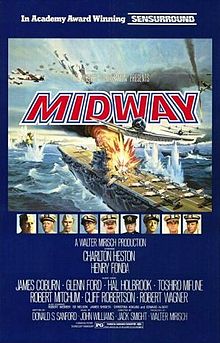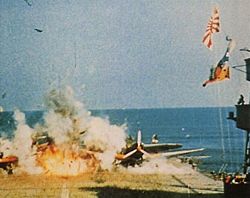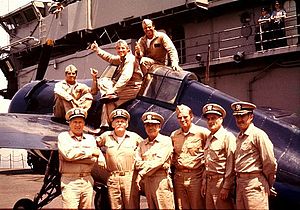- Midway (film)
-
Midway 
original film posterDirected by Jack Smight Produced by Walter Mirisch Written by Donald S. Sanford Starring Charlton Heston
Henry FondaMusic by John Williams Cinematography Harry Stradling Jr. Editing by Robert Swink
Frank J. UriosteStudio The Mirisch Corporation Distributed by Universal Release date(s) June 18, 1976 (US) Running time 132 minutes Country United States Language English Box office $43,220,000 (US:1976)[1] Midway is a 1976 war film directed by Jack Smight and produced by Walter Mirisch from a screenplay by Donald S. Sanford.[2][3] The music score was by John Williams and the cinematography by Harry Stradling, Jr. The film features an international cast of superstars including Charlton Heston, Henry Fonda, James Coburn, Glenn Ford, Hal Holbrook, Toshirō Mifune, Robert Mitchum, Cliff Robertson, Robert Wagner, James Shigeta, Pat Morita, Robert Ito and Christina Kokubo, among others.
The soundtrack used Sensurround to augment the physical sensation of engine noise, explosions, crashes and gunfire.
Contents
Plot
The film chronicles the Battle of Midway, a turning point in World War II in the Pacific. The Imperial Japanese Navy had been undefeated until that time and out-numbered the American naval forces by four to one.
The film follows two threads, one centered around the Japanese chief strategist Admiral Isoroku Yamamoto (played by Mifune), and the other around fictional characters, Captain Matt Garth (Heston), an American naval officer who is involved in various phases of the US planning and execution of the battle and Garth's son (also a pilot involved in the battle) is romantically involved with Haruko Sakura (Kokubo), an American-born daughter of Japanese immigrants, who has been interned with her parents. Garth calls in all of his favors with a long-time friend to investigate the charges against the Sakuras (apparently with success, as Haruko is free and at dockside when the injured younger Garth is carried off the ship at the end of the film)
The film starts with the Doolittle raid, and so takes place before the Battle of the Coral Sea (which is only mentioned). It depicts the creation of a complicated battle plan. Unknown to the Japanese, American signals intelligence has broken the Japanese Naval encryption codes and know ahead of time that the ambush will take place at Midway Island. American Admiral Chester Nimitz (played by Fonda), plays a desperate gamble by sending his last remaining aircraft carriers to Midway before the Japanese to set up his own ambush.
Successful in saving Midway, but at a heavy cost, Nimitz reflects that Yamamoto "had everything going for him", asking "were we better than the Japanese, or just luckier?"
Background and production
The film was shot at the Terminal Island Naval Base, Los Angeles, California, the U.S. Naval Station, Long Beach, California and Pensacola, Florida. The on-board scenes were filmed in the Gulf of Mexico aboard the USS Lexington. The Lexington, a World War II-era carrier that was decommissioned in 1991, was the longest-serving carrier in history. She is now a museum ship at Corpus Christi, Texas.
A PBY-6A Catalina BuNo 63998, N16KL, of the Confederate Air Force, was used in depicting all the search and rescue mission scenes.
It was the second of only four films released with a Sensurround sound mix which required special speakers to be installed in movie theatres. The other Sensurround films were Earthquake (1974), Rollercoaster (1977), and Battlestar Galactica (1978). The regular soundtrack (dialog, background and music) was monaural; a second optical track was devoted to low frequency rumble added to battle scenes and when characters were near unmuffled military engines.
Many of the action sequences used footage from earlier films: most sequences of the Japanese air raids on Midway are stock shots from 20th Century Fox's Tora! Tora! Tora! (1970). Some scenes are from the Japanese Toho film Hawai Middouei daikaikusen: Taiheiyo no arashi (1960) (which also stars Mifune). Several action scenes, including the one where an A6M Zero slams into the Yorktown's bridge, were taken from Away All Boats (1956); scenes of Doolittle's Tokyo raid at the beginning of the film are from Thirty Seconds Over Tokyo (1944). In addition, most dogfight sequences come from wartime gun camera footage or from the film Battle of Britain (1969).
As with many "carrier films" produced around this time, the US Navy Essex class aircraft carrier USS Lexington played the parts of both American and Japanese flattops for shipboard scenes.
Authenticity of the combat footage
The film uses real combat footage, but not necessarily of the actions portrayed. The U.S. carrier fighter-planes in the Battle of Midway were Grumman F4F Wildcats, and the film does use footage of Wildcats, flying in formation. Mention is made of the Brewster F2A Buffalo, which was employed extensively in the real battle, but no aircraft of this type are seen in the film. However, several scenes of combat action and carrier landings in the movie show the later era and visibly distinct F6F Hellcat and F4U Corsair. On the Wildcat, the wings are straight and mounted midway through the fuselage. The Hellcat is very similar, but with the wings mounted much lower (under the fuselage), another distinctive feature is the F6F's 'Smile', while the Corsair, in contrast, has inverted gull-wings. In combat, stock Spitfire and Hurricane images from Battle of Britain were used to make up for the Wildcats and Buffaloes.
All the scenes of American single-engined bombers flying in formation are of SB2U Vindicators (actually in use at that time), so that the famous attack by Torpedo Squadron 8 (VT-8), made in Douglas TBD-1 Devastators, is depicted by Vindicators in formation, but with SBD Dauntlesses making the actual attack. The sole survivor, ensign George H. Gay, Jr., is then seen crashing into the ocean, using footage of a single-seater Hellcat fighter. A little later, an attack by Dauntless dive bombers is portrayed by the same Vindicators in formation, but with Dauntless's making the actual attack, with a Corsair mixed in.
 Japanese carrier hit by US bombs (for this scene, Midway editors used stock footage from the Japanese movie 太平洋风暴 Hawai Middouei daikaikusen: Taiheiyo no arashi, 1960).
Japanese carrier hit by US bombs (for this scene, Midway editors used stock footage from the Japanese movie 太平洋风暴 Hawai Middouei daikaikusen: Taiheiyo no arashi, 1960).
According to Robert Osborne, the host of the Turner Classic Movies channel, the film relied heavily on combat footage shot on color film stock which is more likely to have been shot by the U.S. Navy after the battle.[4][5]
Other scenes include footage of German Bf 109 and He 111 aircraft which did not participate in the actual battle, possibly the result of using stock footage from the film Battle of Britain.[citation needed] The film does not depict the first air attacks launched by B-17 Flying Fortresses, B-26 Marauders, and TBF Avengers. In at least one scene, an aircraft carrier is shown to have an "angled" deck, an innovation developed after the war. World War II era carriers had straight-decks.
These inaccurate depictions resulted from various limitations, including the desire to make use of contemporary color film footage, which was both rare and mostly absent with regards to the actual events being portrayed in the film. The 18-minute John Ford documentary, The Battle of Midway, was shot during the battle in color, though the footage was all shot from the island of Midway and thus offered no footage of aerial combat or naval operations. Stock footage from other theatrical films was used to augment the available wartime footage, namely from Battle of Britain and Tora! Tora! Tora! (U.S. Navy battleship masts, of which there were none in this action, are visible in certain attack scenes, borrowed from Tora! Tora! Tora!).
Other inaccuracies
Four historic inaccuracies are depicted in the scene where the Japanese aircraft carriers are destroyed.
- A bomb is depicted as blasting the bridge of the carrier Akagi and shattering the interior; this happened to the Kaga.
- The scene also shows aircraft from the Yorktown attacking the Kaga; Yorktown's aircraft actually focused their attack on the Soryu.
- The film depicts planes from the Yorktown sinking the Japanese aircraft carrier Hiryū. In reality the Yorktown's surviving aircraft were landed aboard Enterprise and combined with Enterprise aircraft to deliver the final attack on Hiryu.
- Lt. Tomonaga is shown purposely crashing his plane into an American warship. Kamikaze attacks were not officially undertaken until after 1943, and while such suicide attacks by damaged Japanese aircraft did occur, there were no such attacks recorded during the Battle of Midway except by a US Marine dive bomber pilot during the attack on the Mikuma after the main engagement ended. Tomonaga's plane mostly likely crashed into the sea after receiving flak damage.
Also, the movie gives no clear reference as to Yorktown's fate after being hit by 2 torpedoes from carrier planes launched by Hiryū. After having her engines knocked out, she was taken under tow, on her way back to Pearl Harbor for repairs. The Japanese submarine I-168, serving as part of the Japanese patrol group between Midway and Pearl Harbor, sank her before she returned to base. No mention is made of this attack.
In addition, the movie gives the date of 6 June, 1942 as to when the US Navy found the fourth Japanese "flattop" and then sent an attack to destroy it when, in actuality, all four Japanese carriers were attacked and badly damaged by 10:00 of 4 June. The film fails to mention that the Japanese and American carriers were on different sides of the international dateline. The film gives the date and time of the initial Japanese attack at 04:30 on 4 June; the American carriers were and Midway was (and still is) on the other side of the international dateline, so the Japanese attack on Midway occurred at about 07:00 on 3 June, given the fact that it took the Japanese warplanes 2.5 hours to reach Midway from their carriers.
Internment in Hawaii
The film portrays a young Japanese-American woman, Haruko, and her Issei parents interned near Pearl Harbor naval base. This is explained as having been due to Haruko's father making frequent visits to the Japanse Consulate and her membership in various Japanese cultural associations.
However, only 1,800 citizens and residents of Japanese ancestry were interned in Hawaii (as compared to over 110,000 in California). By June, 1942, most had been moved to internment camps on the mainland (a fate planned for Haruko and her family, and prevented by Garth). The closest internment camp to Pearl Harbor was on Sand Island, a former quarantine island on the Honolulu waterfront just east of the mouth of the harbor. Sand Island housed prominent Issei social and religious leaders and separated men's quarters from women's. The film shows Haruko's parents sitting together in a shared room and Haruko defends them as being introverted and harmless recipients of Japanese patriotic magazines and newspapers; a situation that would have been common in California. Internees at Sand Island had at least one member of their family assessed as a major security risk, such as her father's visits to the Consulate (explained by Haruko as meeting with old friends).
TV version
Shortly after its successful theatrical debut, additional material was assembled and shot in standard 1.33:1 ratio for a TV version of the film. A major character was added: Susan Sullivan played Ann, the girlfriend of Captain Garth, adding depth to his reason for previously divorcing Ensign Garth's mother, and bringing further emotional impact to the fate of Captain Garth. The TV version also has Coral Sea battle scenes to help the plot build up to the decisive engagement at Midway. The TV version was 33 minutes longer than the film and was aired as a two-part special.
Part of this additional footage is available as a bonus feature on the Universal Pictures Home Entertainment DVD of Midway.
Reception
Robert Niemi, author of History in the Media: Film and Television, stated that Midway's "clichéd dialogue" and an overuse of stock footage lead the film to have a "shopworn quality that signalled the end of the heroic era of American-made World War II epics." He described the film as a "final, anachronistic attempt to recapture World War II glories in a radically altered geopolitical era, when the old good-versus-evil dichotomies no longer made sense."[6]
Cast
 Nine members of the cast near a Wildcat fighter on the flight deck of USS Lexington, today a museum ship
Nine members of the cast near a Wildcat fighter on the flight deck of USS Lexington, today a museum ship
See also
- List of historical drama films
- List of historical drama films of Asia
References
- ^ IMDB Box office/business
- ^ Variety film review; June 16, 1976, page 18.
- ^ "'Midway' writer Donald S. Sanford dies at 92". Variety. 2011-02-15. http://www.variety.com/article/VR1118032330?refCatId=13. Retrieved 2011-02-24.
- ^ One SBD Dauntless dive bomber (flown by Charlton Heston's character) shown to be involved in an accident with the aircraft carrier's ramp was actually shot in part during the Korean War. (The scene in Midway shows an SB2C Helldiver striking the ramp before turning into an F9F Panther jet fighter bomber as it explodes. The latter accident was non-fatal in real life and involved Cdr. Duncan of CV-41, USS Midway, 23 July 1951. In addition to its use in Midway, Cdr. Duncan's crash was featured in 1954's Men of the Fighting Lady as the demise of Keenan Wynn's Lt. Cdr. Ted Dodson and later in 1990's The Hunt for Red October as a damaged F-14 Tomcat.)
- ^ Check-Six.com - George Duncan's F9F Crash
- ^ Niemi, Robert. History in the Media: Film and Television.ABC-CLIO, 2006, p. 119. Retrieved on April 9, 2009.
External links
- Midway at the Internet Movie Database
- Midway at the TCM Movie Database
- Midway at AllRovi
Films directed by Jack Smight 1960s I'd Rather Be Rich (1964) · The Third Day (1965) · Harper (1966) · Kaleidoscope (1966) · The Secret War of Harry Frigg (1968) · No Way to Treat a Lady (1968) · Strategy of Terror (1969) · The Illustrated Man (1969)1970s Rabbit, Run (1970) · The Traveling Executioner (1970) · The Man from Independence (1974) · Airport 1975 (1974) · Midway (1976) · Damnation Alley (1977) · Fast Break (1979)1980s Categories:- American films
- English-language films
- 1976 films
- Aviation films
- Seafaring films based on actual events
- Universal Pictures films
- War epic films
- War films based on actual events
- United States Navy in World War II films
- Epic films
- Films set in Oceania
- Films set in United States territories
Wikimedia Foundation. 2010.
